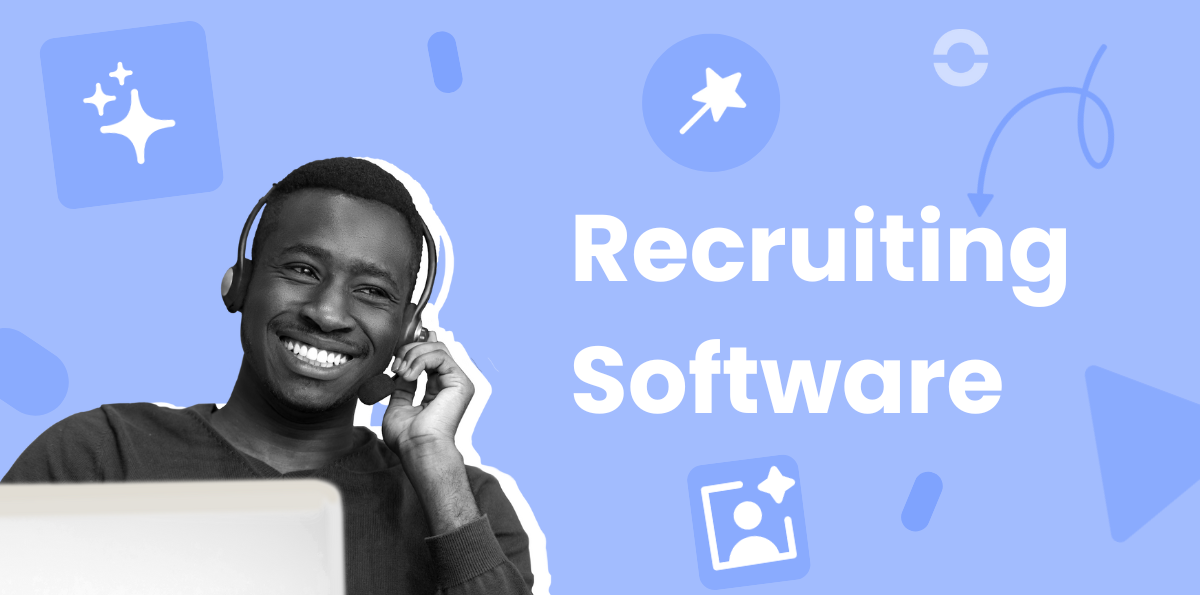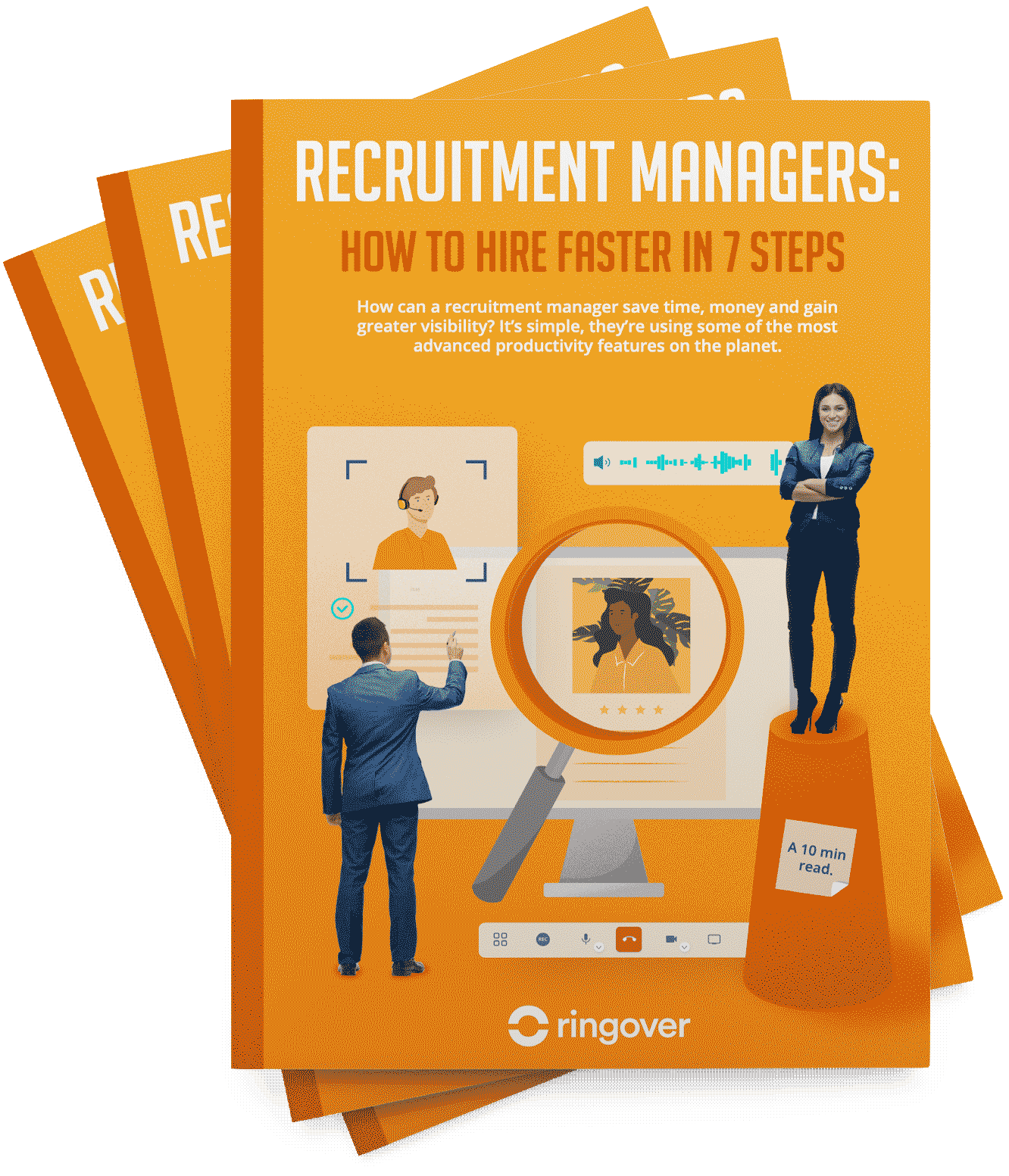Summary
- What is the Best Recruiting Software?
- List: 10 Top Cloud-based Recruiting Software
- What types of software do staffing firms use?
- What is Cloud-Based Recruiting?
- How Does Cloud-Based Recruiting Software Work?
- Benefits of Recruiting Software
- Challenges of Recruiting Software
- Most Important Features of a Cloud-based Recruitment Software
- Final Thoughts on Recruiting Software
- Recruiting Software FAQ
These powerful cloud-based recruiting software support a range of staffing activities, from advertising vacancies and managing applicant pools to screening potential hires, evaluating their skills, and efficiently integrating new employees into the company.
Discover Ringover for Recruitment
For hiring managers and recruitment agencies, the adoption of recruiting software means a drastic cut in manual labor, an upgrade in the quality of the candidate experience, and the ability to make smarter, evidence-based recruitment choices.
What is the Best Recruiting Software?
Ultimately, the "best" recruiting software is one that aligns with your organization's unique needs, budget, and hiring strategies. It's important to evaluate different options through free trials or demos to determine which platform best fits your workflow and enhances your recruitment process.
With that being said, there are a few options that stand out. For example, Ringover's business phone system allows you to connect with clients and candidates easily and efficiently. With this omnichannel software on hand, you'll reach your contacts on the channel they prefer, be it via phone, text, WhatsApp, video call, etc.
List: 10 Top Cloud-based Recruiting Software
1. Empower by Ringover
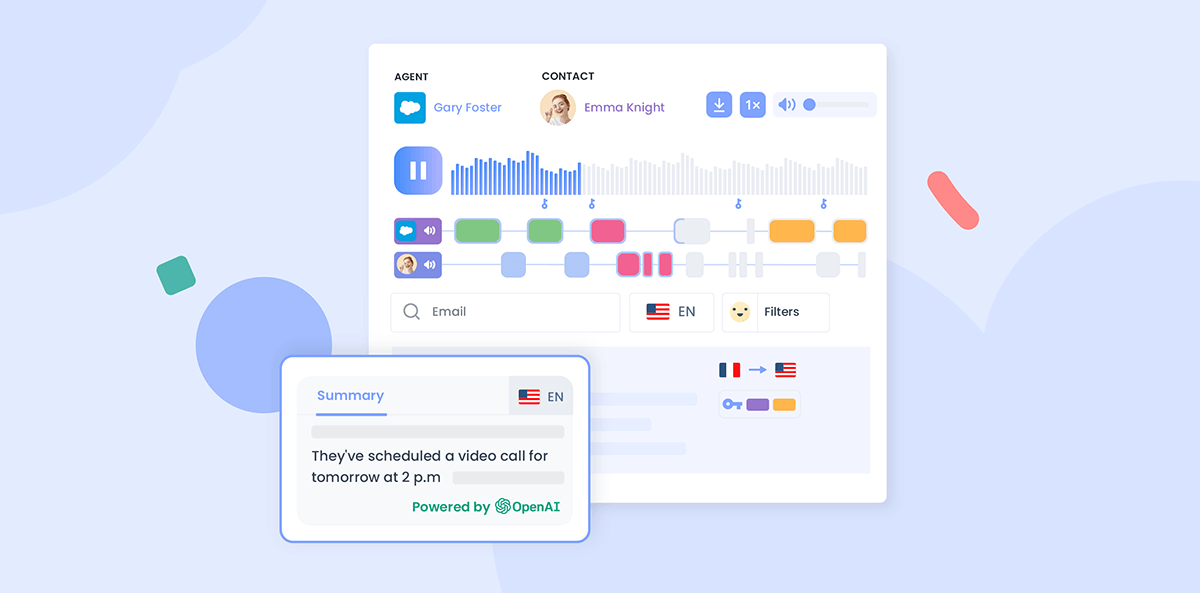
AI is also a key component of cloud recruitment software, as it gives incredible insight into clients and candidates. Empower by Ringover is an AI conversational software which automatically transcribes and summarizes conversations. These conversations are then analyzed by conversation intelligence software and sentiment analysis to identify the topics discussed, emotions expressed, and surface advanced analytics. The end result? Every conversation becomes an opportunity for increased revenue thanks to the insight gained and opportunities uncovered.
Empower by Ringover Pricing 💰
$69 per user/month
Empower by Ringover Pros ✅
- Identifies topics and emotions expressed during interactions
- Transforms hours of audio and video data into searchable resources thanks to tags and automatically identified call moments
- Optimize performance thanks to individual and team metrics
- Free trial available
2. Ringover

Ringover offers an IP telephony solution that stands out for its omnichannel communication features, unlimited calling to more than 110 countries, IVR menus, and detailed analytics, making it an essential tool for recruiters seeking to optimize their recruiting business development and include more personalization in recruiting.
Ringover Pricing 💰
- Smart plan: $21 per user/month
- Business plan: $44 per user/month
- Advanced plan: Price on request
Ringover Pros ✅
- Supports multiple channels of communication
- Unlimited calls to over 110 destinations
- Includes comprehensive analytics
- Free trial available
3. Manatal
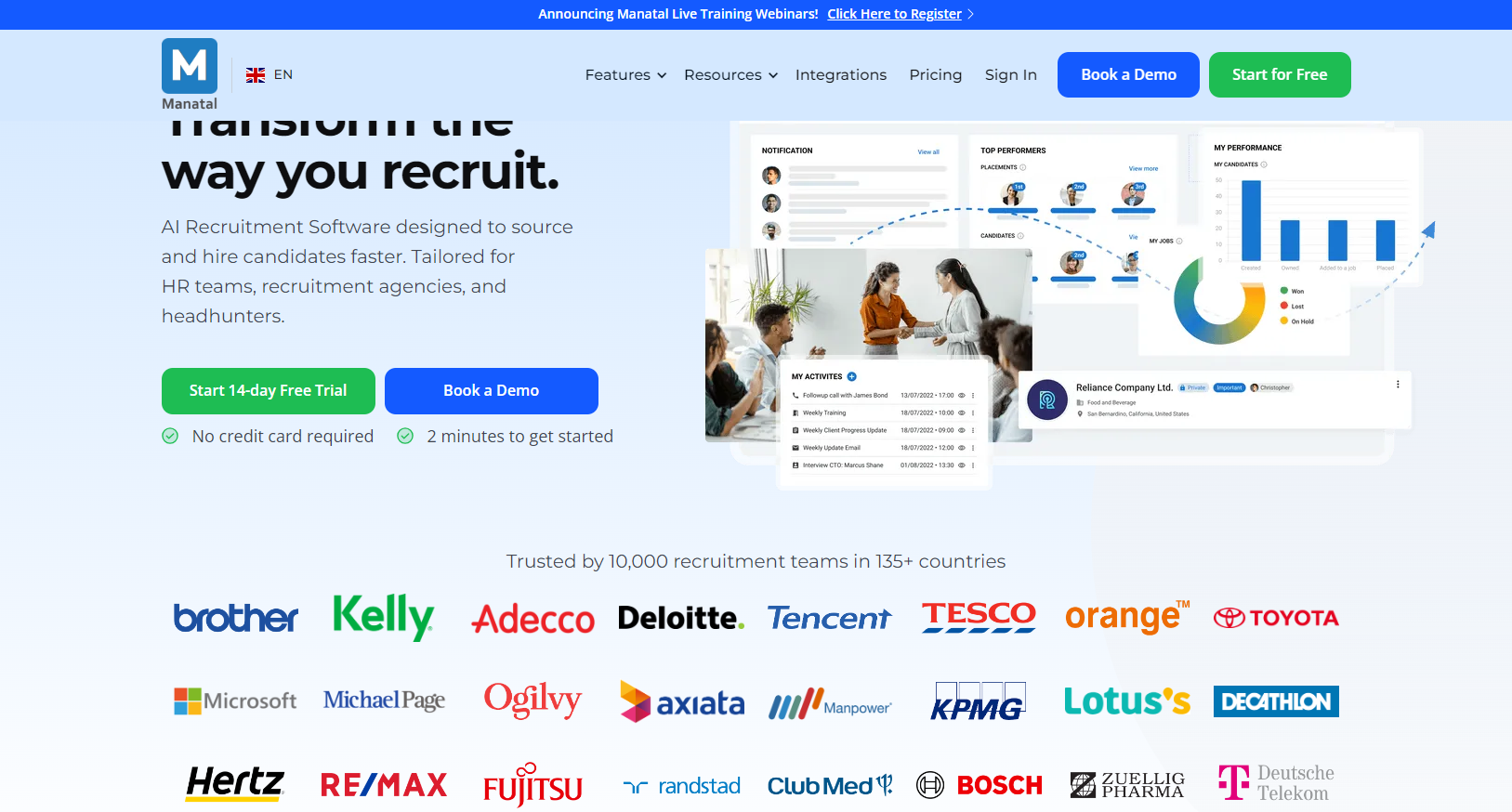
Manatal introduces a cloud-based recruitment solution that leverages AI for automation from sourcing to onboarding. It also features a CRM platform for improved management of clients and candidates, suitable for both agencies and businesses.
Manatal Pricing 💰
- Professional: $15/user/month
- Enterprise: $35/user/month
- Custom plans are available
Manatal Pros ✅
- User-friendly interface
- AI-driven candidate tracking to improve recruitment KPIs
- Integration with job boards and career pages
- 14-day free trial available
Manatal Cons ❌
- Limited features for internal integration
- Missing advanced functionalities
4. Zoho Recruit

Zoho Recruit is a comprehensive ATS designed for the needs of small to medium-sized businesses, covering all end-to-end recruitment from job postings to managing interviews and tracking candidates.
Zoho Recruit Pricing 💰
- Free tier
- Various paid plans, with Enterprise plan being less than $75/user/month
Zoho Recruit Pros ✅
- 45-day money-back guarantee
- 15-day free trial
- Over 50 integrations
- Features automated calendar scheduling
5. Bullhorn
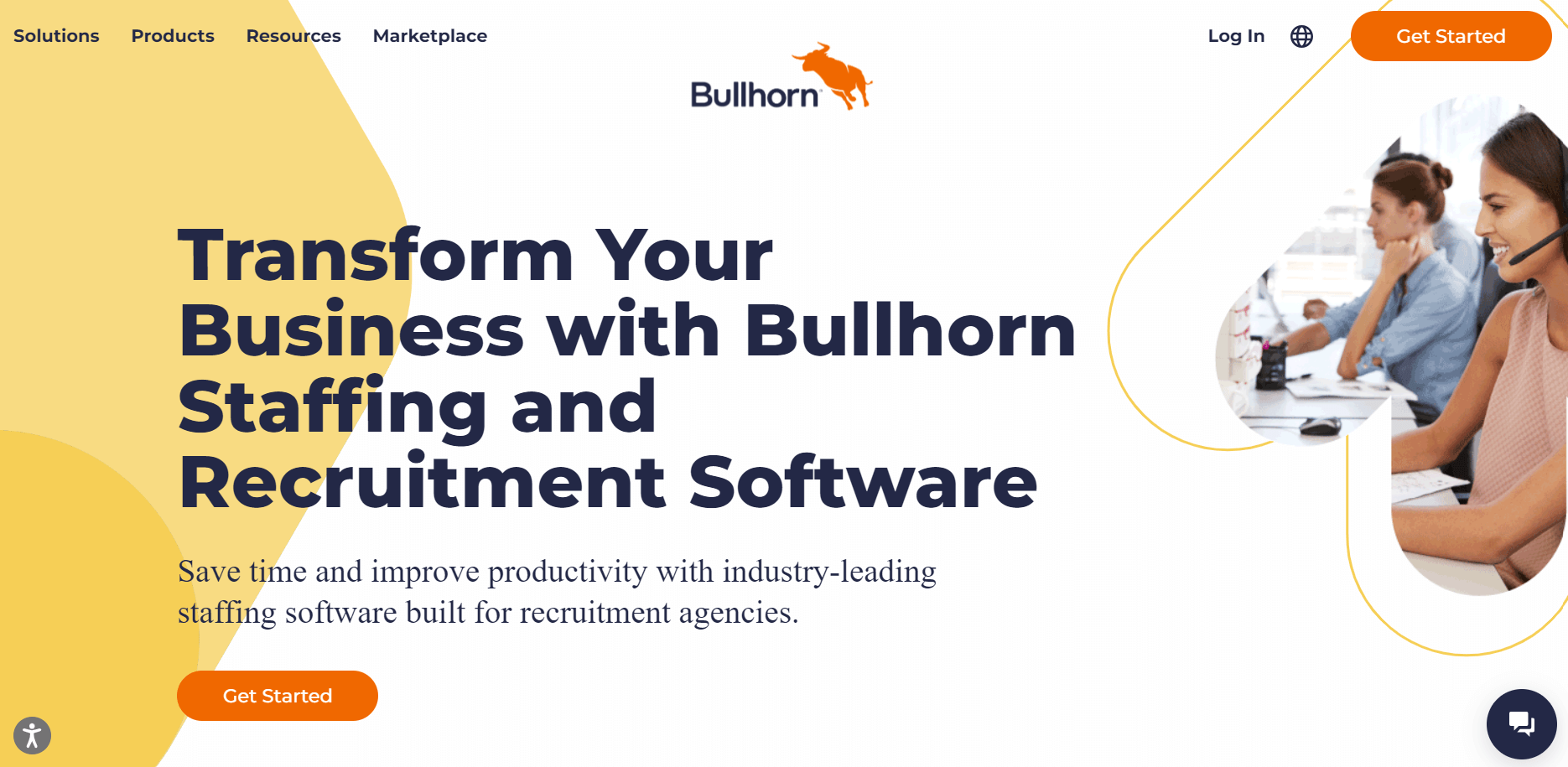
Bullhorn combines an applicant tracking system with CRM capabilities, tailored for recruiting and staffing agencies to manage candidate and client relationships efficiently.
Bullhorn Pricing 💰
- Contact for custom pricing.
Bullhorn Pros ✅
- Centralizes candidate information in one database
- Rich in automation features
- Incorporates reporting and analytics
6. Greenhouse

Greenhouse offers a scalable solution that automates the entire hiring workflow from recruitment to onboarding. It stands out with over 400 integrations, positioning itself as a top choice for midsize to large companies.
Greenhouse Pricing 💰
- Contact for custom pricing.
Greenhouse Pros ✅
- Advanced tools for onboarding
- Insights into diversity metrics
- Structured approach to hiring
- Mobile application available
Greenhouse Cons ❌
- May be costly for smaller organizations
- Limited integration with calendars
7. Jobvite

Jobvite is a recruiting automation software featuring a candidate relationship management tool for tracking passive candidates and a job description grader for inclusivity and compliance.
Jobvite Pricing 💰
- Contact for custom pricing.
Jobvite Pros ✅
- Supports blind recruitment for diversity
- Mobile app for iOS and Android
- Integrates job broadcasting and social media
Jobvite Cons ❌
- Interface may not be user-friendly
- Limited management of candidates
- No 24/7 live support
8. Workable

Workable simplifies hiring for more effective recruitment. The features include tools for sourcing candidates, evaluation and assessment, including detailed analytics and mobile access.
Workable Pricing 💰
- Starter plan: $249/month
- Standard plan: $349/month
- Premier plan: $679/month
Workable Pros ✅
- Intuitive user interface
- Free trial available
- Over 200 integrations
- AI recommendations for candidates
Workable Cons ❌
- Limited customization options
- Search functionality could be improved
9. JazzHR
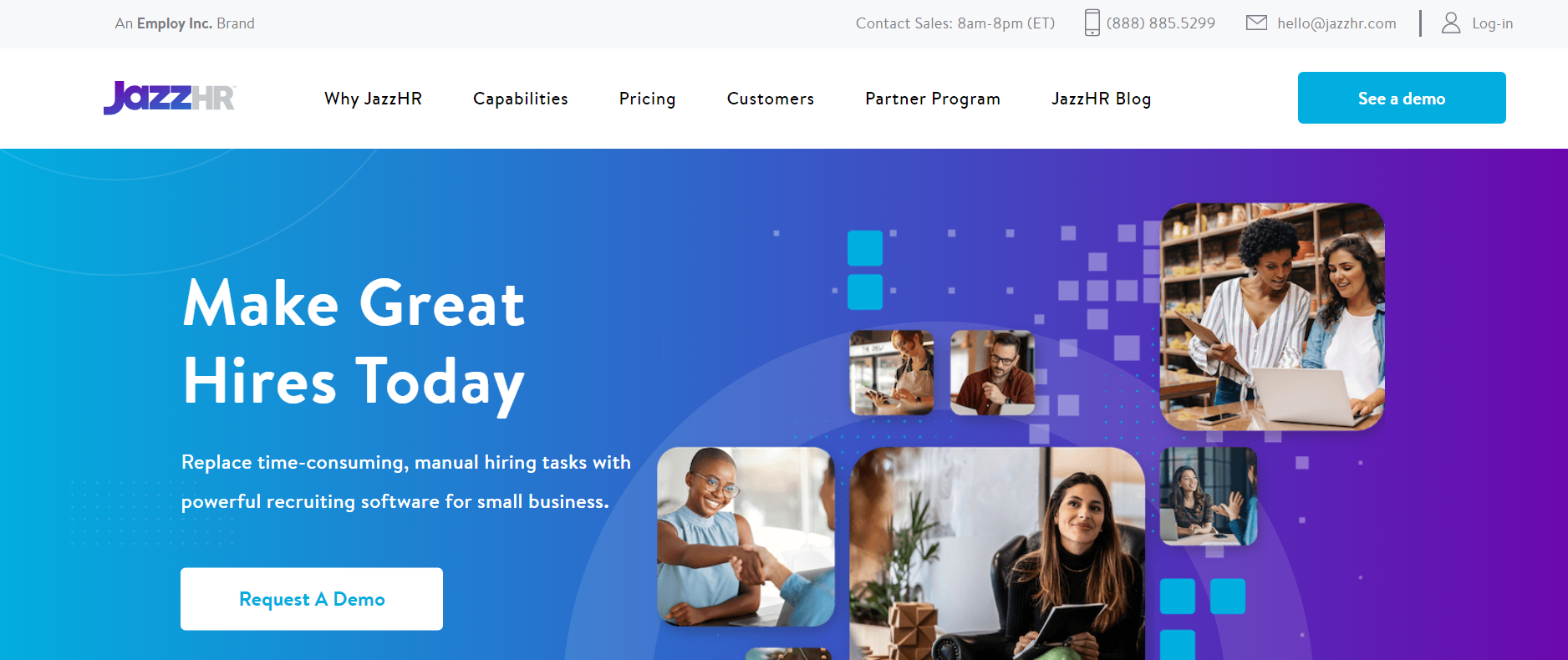
JazzHR aims to make hiring both effective and affordable for companies of any size, offering a wide range of functionalities including job board posting and social media recruitment tools.
JazzHR Pricing 💰
- Hero Plan: $75/month
- Plus Plan: $269/month
- Pro Plan: $420/month
JazzHR Pros ✅
- Easy to use
- Supports unlimited jobs and users
- Integrates with HR software
- Includes an employee referral system
JazzHR Cons ❌
- No mobile app available
- Support for languages is limited
10. Loxo
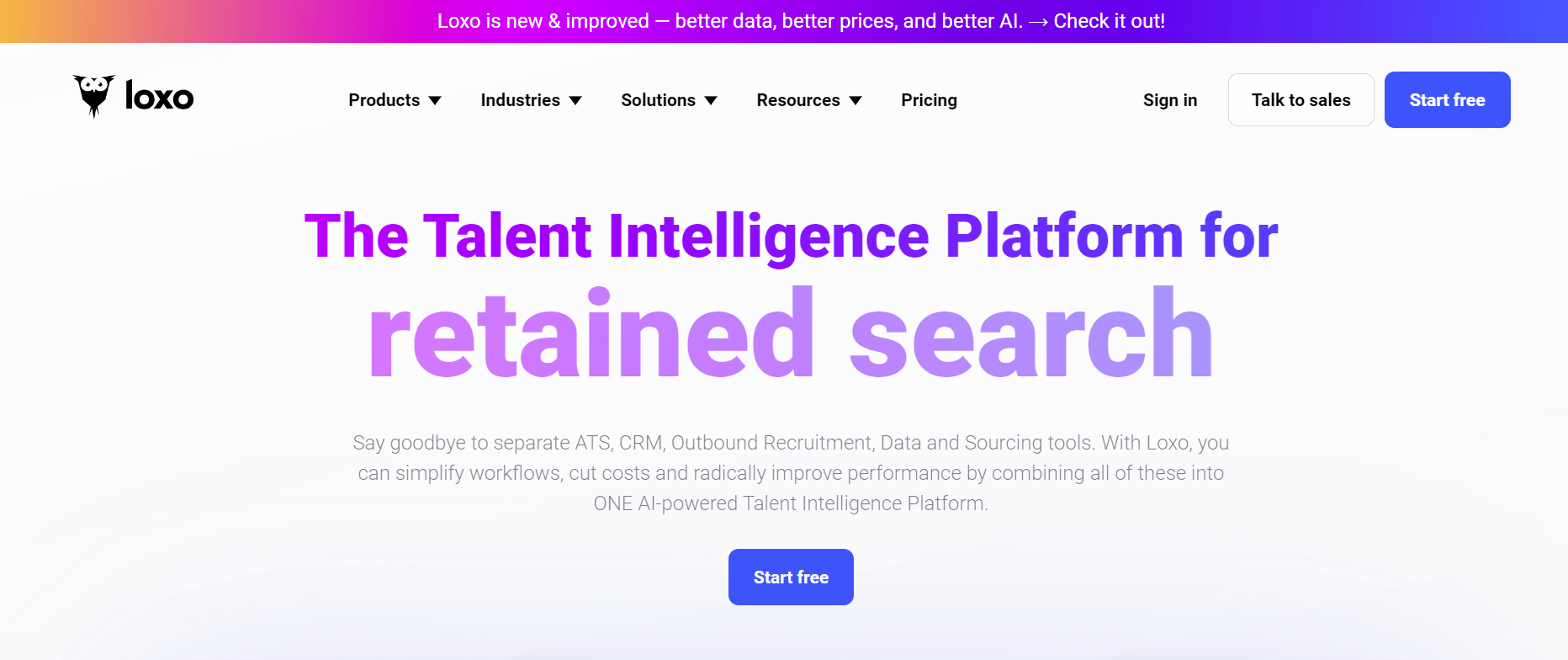
Loxo offers a modern approach to recruiting software by combining ATS and CRM functionalities. It features automated candidate sourcing, assessment management, and comprehensive reporting.
Loxo Pricing 💰
- A free plan is available
- Starter Pack: $119 per user/month
- Professional and Enterprise Plan: Customizable pricing
Loxo Pros ✅
- Utilizes AI for a range of features
- Automation tools save time
- Seamlessly integrates with other systems
Loxo Cons ❌
- Lacks a mobile application
- Search functionality has room for improvement
What types of software do staffing firms use?
Staffing firms utilize a variety of software categories to streamline their operations, enhance efficiency, and improve the overall recruitment process. Here are some of the key types of software that are commonly used:
Business Phone System
A business phone system, particularly a VoIP phone system, is essential for staffing firms. These systems, such as the features offered by Ringover, enable recruiters to conduct interviews remotely, manage high-volume outreach campaigns, and provide a seamless candidate and customer experience.
Key features include call routing, recruiting text messages, and centralized omnichannel communications, which help in organizing and tracking all candidate interactions in one interface.
Conversational AI Software
Conversational AI software is increasingly being adopted by staffing firms to automate and enhance candidate interactions. This type of software uses AI hiring tools to handle initial candidate screenings, answer common questions, and even schedule interviews.
Tools like Empower by Ringover leverage AI to automate recruitment prospecting, making the process more efficient and reducing the workload on recruiters.
Applicant Tracking System (ATS)
An ATS is a fundamental tool for staffing firms, acting as a central database for managing candidates throughout the hiring process. These systems, such as Zoho Recruit, Manatal, and Bullhorn, help in creating and posting job ads, receiving applications, and automating communication with candidates. They also facilitate interview scheduling, resume screening, and provide detailed analytics to improve the hiring process.
Candidate Relationship Management (CRM) Software
CRM software is essential for staffing firms to manage both candidate and client relationships effectively. Tools like Recruiterflow, Recruit CRM, and Bullhorn offer advanced CRM functionalities that help in tracking candidate interactions, managing pipelines, and ensuring that no potential candidate or client falls through the cracks. These systems also provide robust reporting and analytics to help staffing firms make informed decisions.
Staffing Software
Staffing software is a comprehensive solution designed specifically for staffing agencies. It encompasses a wide range of features including job posting, candidate sourcing, resume management, interview scheduling, onboarding, and integrated payroll and billing systems. Software like Avionté, Ceipal, and Loxo streamline the entire recruitment and placement process, ensuring compliance with labor laws and providing robust reporting and analytics.
By leveraging these different types of software, staffing firms can significantly enhance their operational efficiency, improve candidate and client relationships, and ultimately, hire the best talent more effectively.
What is Cloud-Based Recruiting?
Cloud-based recruiting utilizes cloud-managed platforms to streamline the recruitment process comprehensively. This method takes advantage of cloud computing, offering a scalable, accessible, and efficient approach to managing all facets of talent acquisition.
These cloud-based solutions are maintained on remote servers, accessible over the internet from any device, anytime, anywhere. This level of flexibility is particularly beneficial for recruiters who frequently work remotely or participate in various recruitment events.
Key Characteristics
Below are some primary characteristics of cloud-based recruiting:
- Accessibility and Flexibility: Cloud-based platforms provide recruiters the ability to access their data and oversee the recruitment process from any device connected to the internet. This enables recruiters to remain productive whether they're in the office, at a job fair, or traveling for business.
- Scalability: The inherently scalable nature of cloud solutions allows for adjustments in subscription plans to match changing recruitment needs, avoiding the need for costly hardware or software license investments and offering a cost-effective solution.
- Centralized Platform: Most cloud-based recruiting software offers a comprehensive platform that handles the entire recruitment cycle — from posting jobs and managing applications to candidate screening, interviewing, and onboarding. This centralization simplifies the recruitment process by eliminating the need to juggle multiple disparate systems.
How It Works
Cloud-based recruiting platforms provide a web-based or mobile application interface, enabling recruiters to conduct all recruitment-related activities. Here's an overview of how it operates:
- Job Posting and Application Management: Recruiters can distribute job openings across various job boards and manage applications through a unified dashboard. Automated tools assist in filtering and shortlisting candidates based on set criteria.
- Candidate Screening and Interviewing: With advanced features like video interviewing and AI-powered assessment tools, the screening and interviewing process is streamlined, reducing manual workload and enhancing recruitment efficiency.
- Collaboration and Communication: Cloud-based platforms support real-time collaboration between recruitment teams, hiring managers, and other stakeholders. Integrated communication tools and notifications help keep everyone informed, minimizing errors and improving the candidate experience.
By leveraging these features, cloud-based recruiting solutions revolutionize the recruitment process, making it quicker, more efficient, and more effective at sourcing and hiring the best talent.
How Does Cloud-Based Recruiting Software Work?
Cloud-based recruiting software utilizes cloud computing to create a powerful, accessible, and scalable solution for managing the entire recruitment process. Deploying such software is a key part of the digital transformation in recruiting and makes a huge improvement in productivity and efficiency. Let's explore its functionality in detail:
Hosting and Access
Hosted on remote servers by the software provider, cloud-based hiring management software allows users to access the platform via a web browser or mobile app from any location with an internet connection. This feature is especially useful for recruiters working remotely or needing to handle recruitment from various locations.
Core Functionalities
The main features of cloud-based recruiting software include:
- Job Posting and Management: This allows users to advertise job openings on multiple job boards, manage career portals, and monitor the status of job postings in real-time, ensuring broad visibility and centralized application management.
- Candidate Application and Tracking: The software supports the collection, parsing, and tracking of candidate applications, including resume screening, skill assessments, candidate relationship management, and automated candidate matching with AI tools.
- Interview Scheduling and Conducting: It also includes tools for scheduling and conducting video interviews, streamlining the evaluation process and minimizing the time spent on manual scheduling.
- Communication and Collaboration: Built-in communication tools allow for efficient interaction with candidates and hiring teams, featuring automated emails, notifications, and real-time collaboration capabilities to keep everyone informed and aligned.
Automation and Analytics
Cloud-based recruiting software enhances efficiency with advanced automation and analytics:
- Workflow Automation: Recruiters can automate processes for different recruitment stages, like sending follow-up emails or delegating tasks, which cuts down on manual labor and boosts productivity.
- Advanced Analytics and Reporting: Offering detailed insights on recruitment KPIssuch as time-to-hire, source of hire, and candidate satisfaction, these analytics support data-driven decision-making and process improvement.
Integration and Customization
The software is built for seamless integration with other HR and recruitment tools:
- Integration with Other Software: It can connect with social media, job boards, HR software, and more, facilitating a unified recruitment process through APIs and web technologies. More specifically, there are many Bullhorn integrations and Vincere integrations, most notably with Ringover.
- Customization: With customizable dashboards, workflows, and user interfaces, organizations can adapt the software to meet their specific requirements, enhancing both usability and effectiveness.
Ringover’s business phone system and omnichannel software allow you to reach clients and candidates on the channel they prefer, providing a more personalized and efficient experience.
Benefits of Recruiting Software
Implementing recruiting software can bring numerous benefits to organizations, significantly enhancing their recruitment processes. Here are some of the key advantages:
Efficiency and Speed
One of the most significant benefits of recruiting software is the automation of various recruitment tasks. This includes resume screening, scheduling interviews, communicating with candidates, and posting job ads. By automating these tasks, the hiring process is significantly sped up, and the number of manual tasks recruitment teams have to perform is reduced.
Improved Candidate Experience
Recruiting software helps in providing a better experience for candidates through regular communication, quick feedback, and a streamlined process. This positive experience increases the likelihood of candidates accepting job offers and leaves a favorable impression of the organization.
Enhanced Collaboration
The software facilitates enhanced collaboration among recruitment team members by allowing them to share feedback, evaluate candidates collectively, and make decisions more efficiently. Real-time collaboration features ensure stakeholders are on the same page, reducing miscommunications and improving productivity.
Data-Driven Decisions
Recruiting software often includes analytics and reporting features that provide valuable insights into key recruitment metrics. This enables organizations to make informed decisions and improve their hiring strategies based on data-driven evidence.
Better Quality of Hire
Advanced tools within the software, such as skills tests and interview evaluations, help in selecting candidates who are a better fit for the role and the company. This leads to higher quality hires and reduced turnover rates.
Cost Savings
By reducing the time to hire and automating repetitive tasks, recruiting software can lower the overall cost of the recruitment process. Additionally, cloud-based solutions often have lower starting costs and reduced maintenance expenses compared to traditional desktop software.
Scalability
Recruitment software is highly scalable, capable of handling large volumes of applications and adapting to the changing needs of a growing organization. This makes it suitable for businesses of all sizes, from small startups to large enterprises.
Centralized Data Management
All candidate information, job postings, and communication history are stored in a centralized database, making it easier to manage and retrieve data. This centralized approach helps in building a comprehensive candidate database and ensures that important information is not misplaced.
Compliance and Security
Recruiting software helps ensure that hiring practices comply with legal and regulatory requirements, protecting the organization from potential liabilities. The software also provides robust security measures to safeguard sensitive candidate and client data.
Enhanced Sourcing
Advanced search and filtering capabilities, often powered by AI, allow recruiters to source candidates quickly and efficiently. This includes identifying passive candidates who may not otherwise see the organization's job ads.
Integration with Other Systems
Many recruiting software solutions can integrate with other HR software and business systems, creating a seamless workflow from recruitment to onboarding and beyond. This integration ensures a cohesive and efficient hiring process.
Reduction of Bias
Some recruiting software includes features designed to promote diversity and inclusion, such as anonymized candidate profiles and diversity reporting. These features help in reducing bias in the hiring process and promoting a more inclusive workplace.
Customizable Templates
Email templates, job description templates, and other customizable documents save time and ensure consistency in communication and documentation. This helps maintain a professional and uniform approach to candidate interactions.

Challenges of Recruiting Software
Recruiting software may help overcome staffing industry challenges, yet it's not without its drawbacks. Organizations should be aware of these potential pitfalls:
Limited Capabilities Beyond Tracking
Most ATS and recruiting platforms focus on tracking applications more than offering proactive hiring solutions or strategic insights. This can lead to overlooked talent and inefficiencies, as these systems may not foresee future hiring needs or enhance recruitment strategies.
Limited Customization and Flexibility
A common issue with ATS platforms is their rigid nature, offering little in terms of customization or flexibility. This forces organizations into inefficient workflows, potentially leading to low adoption rates and user frustration.
Siloed Data and Lack of Integration
Many ATS platforms operate in isolation, with limited integration capabilities, resulting in data silos. This fragmentation complicates gaining a comprehensive view of talent pipelines, increasing manual data entry and the risk of data inconsistencies.
Inadequate Use of AI and Automation
While some recruiting tools incorporate basic automation, many lack advanced AI features required for modern recruitment. This includes predictive analytics, precise candidate matching, bias reduction, and automating repetitive tasks. The absence of these features keeps the recruitment process manual and inefficient.
Resistance to Change and Adaptation
The recruitment field is ever-changing, yet many ATS platforms are inflexible to adapt to new challenges. This leaves firms with outdated systems, hindering their ability to grow and evolve.
Integration Challenges
Integrating recruiting software with other HR systems can be fraught with difficulties, including data mapping issues. This complicates the recruitment process and affects strategic decision-making.
Overemphasis on Data
Some recruiting tools overly focus on data, leading to the exclusion of candidates based on keywords. This "keyword mismatch" can prevent recruiters from accessing top talent.
Candidate Dropout Due to Complex Application Forms
Complex application processes can deter candidates, with data showing around 60% of applicants abandon the process due to length or complexity. This narrows the pool of applicants, potentially excluding qualified candidates early.
High Costs and Perceived Complexity
The perceived complexity and high costs associated with implementing new recruiting software can be deterrents. Concerns about change, learning curves, and potential downtime also contribute to hesitancy.
Lack of Awareness of Advanced Capabilities
Many firms are not fully aware of the advanced capabilities offered by modern recruiting software, such as strategic talent insights, advanced analytics, and automation. This lack of awareness prevents them from transforming their recruitment processes.
Most Important Features of a Cloud-based Recruitment Software
When selecting a cloud-based recruitment software, there are several key features that are essential for optimizing the hiring process. Here are some of the most important features to look for:
Integrations
Robust integration capabilities are essential for a seamless recruitment process. The software should be able to integrate with a wide range of tools and systems, including HR software, job boards, social media platforms, and other business applications. Integrations through platforms like Zapier allow recruiters to connect their favorite apps and automate lightweight tasks, enhancing the overall efficiency of the recruitment workflow.
Omnichannel Communication
Omnichannel communication is vital for engaging candidates effectively across various stages of the recruitment funnel. This feature enables recruiters to use multiple communication channels such as phone calls, text messages, emails, and social media to interact with candidates.
An omnichannel approach ensures a unified conversational thread, allowing recruiters to see the candidate's entire journey and maintain consistent communication, thereby improving the quality of each interaction.
Applicant Tracking System (ATS)
An ATS is a core feature of any recruitment software, helping recruiters manage candidate applications efficiently. It simplifies the collection of resumes, cover letters, and other application materials, preventing recruiters from overlooking any candidates.
The ATS also automates tasks such as resume screening, candidate ranking, and shortlisting candidates who match the job requirements.
Job Posting and Distribution
The ability to post job openings across multiple platforms is critical for attracting a broad pool of potential candidates. Cloud-based recruitment software should allow companies to publish job ads on job boards, social media networks, and career websites, ensuring maximum visibility and reach.
Candidate Screening and Assessment
Tools for screening and assessing applicants are essential for identifying the best candidates. The software should enable recruiters to create customized questionnaires, conduct assessments, and rank candidates based on their qualifications and performance.
This feature helps in shortlisting candidates who closely match the job requirements.
Interview Scheduling and Management
Efficient interview scheduling and management are essential for ensuring smooth coordination between candidates and interviewers. The software should allow recruiters to schedule and manage interviews, send automated interview invitations, and maintain a calendar of upcoming interviews.
Reporting and Analytics
Robust reporting and analytics capabilities are necessary for making data-driven decisions. The software should provide features to generate reports on key recruitment metrics such as time-to-fill, cost-per-hire, and source effectiveness. These analytics help organizations optimize their recruitment strategies and improve overall hiring efficiency.
Centralized Database
A centralized database is vital for storing, managing, and searching through candidate information. This feature ensures that all relevant documents, including resumes, contact details, and notes, are accessible in one place, eliminating the need for physical paperwork and reducing the risk of misplacing important information.
Collaboration and Communication Tools
Effective collaboration and communication among recruitment team members are essential for making informed hiring decisions. The software should provide tools for sharing candidate profiles, exchanging feedback, and communicating with candidates.
This ensures that all stakeholders have access to the latest information and can collaborate in real-time.
Final Thoughts on Recruiting Software
In conclusion, cloud-based recruiting software is a transformative tool for modern hiring processes. It streamlines the recruitment cycle, enhances candidate experience, and provides valuable data-driven insights.
Key points to remember include the importance of integrations, omnichannel communication, and advanced automation features. These tools help in centralizing candidate data, improving collaboration, and reducing the time-to-hire. To get an idea of how these advantages can transform your daily operations, consider a free trial. Both Ringover and Empower by Ringover offer free trials–a great opportunity to see how it works for your business!
Recruiting Software FAQ
Is Recruiting Software Secure and Safe to Use?
Ensuring the security and safety of recruiting software is paramount, given the sensitive nature of the data it handles. Reputable recruiting software providers implement robust security measures such as data encryption, secure online applications, and access control mechanisms to protect candidate and client information.
For instance, employing HTTPS connections, regular software updates, and penetration testing helps identify and address potential security weaknesses. Additionally, compliance with regulations like GDPR is essential, and many providers ensure their systems meet these standards. By choosing a vendor that prioritizes security and compliance, organizations can confidently use recruiting software without compromising data safety.
What is ATS Cloud?
ATS Cloud refers to the hosting of ATS software on cloud-based infrastructure. This means that the ATS is accessed via the internet rather than being installed on local servers.
Cloud-based ATS solutions offer several benefits, including scalability, enhanced collaboration, reduced IT infrastructure costs, and access to advanced technology. Cloud hosting also provides automated backups, disaster recovery services, and scalable storage solutions, ensuring high availability and reliability of the system.
What is ATS vs CRM?
The distinction between an ATS and a CRM system is important to understand when selecting recruitment software.
ATS: An ATS is specifically designed to manage the hiring process of applicants. It tracks candidates from sourcing to onboarding, automates tasks such as job posting, resume screening, and interview scheduling, and stores applicant data. The primary focus of an ATS is on the recruitment process itself, making it an essential tool for in-house recruiters and HR teams.
CRM: A CRM, or Candidate Relationship Management system, is more comprehensive and acts as the backbone of a recruitment agency or business. It manages relationships with both candidates and clients, automates tasks like sending emails and scheduling interviews, and provides reporting tools to measure performance. Unlike an ATS, a CRM is not limited to just the hiring process but also manages the entire recruitment business, including sourcing, engaging, and managing applicants and clients.
The key differences between an ATS and a CRM include:
- Scope: An ATS is focused on the hiring process, while a CRM manages all aspects of the recruitment business.
- Functionality: ATS automates hiring tasks, whereas CRM automates and manages relationships, business processes, and performance metrics.
- User Base: ATS is commonly used by in-house recruiters, while CRM is popular among recruitment agencies and businesses that need to manage multiple processes.
- By understanding these differences, organizations can choose the right tool or opt for a solution that combines the capabilities of both an ATS and a CRM to ensure they have all the necessary functionality for their recruitment needs.
